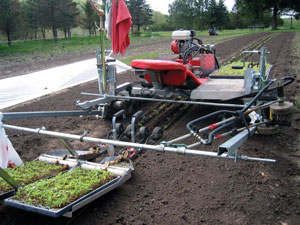3/22/2011
Growing Cut Celosia in Paper-Chain Pots
Joe Schmitt
As growers of cut celosia know, many cultivars behave differently depending on whether they were direct-sown or set out as plugs. Field producers have historically direct sown celosia, with the result of high-quality single stems, albeit at the considerable expense of hand thinning and weeding. While the same results might be achieved with some varieties by setting out very young plugs (2- to 3-week old plugs) in dense plantings, other desirable or more affordable varieties often adopt a branching habit when grown as plugs. This results in thinner, weaker, curved stems and smaller heads. Indeed, all celosia varieties seem to respond by branching if stressed in any number of ways, particularly root disturbance, or by blooming prematurely on stunted plants.
A further complication for would-be growers of celo

sia in its most desirable colors and forms is the focus of recent breeding programs on so-called greenhouse varieties, achieving those marvelous colors and forms at the expense of resilience to field conditions. In addition, the cost of seed has skyrocketed from a few dollars per ounce to some varieties now commanding more than $100 per thousand, or ten cents per seed—hardly a situation where one would want to oversow a crop and thin to a desirable spacing.
As the planter moves forward, the 264 plants in the paper-chain pots pull out of the tray and are dropped into the ground at a precise planting, all without disturbing the plants’ roots.
For these reasons, when I first saw a video of a paper-chain pot system in action (see it at
www.smallfarmworks.com), I knew it could be revolutionary in the production of many crops and, for me, particularly for growing celosia outdoors. Designed for growing scallions in Japan, the ingenious system uses a honeycomb of 264 paper cells filled with plug medium and sown with an offset plate seeder (or by hand). At the desirable stage (from just germinated to four weeks or so, depending on the crop) the tray is placed on a simple hand-pulled device. Pulling on the first plant in the corner of the tray, the rest follow along in a chain, connected by a paper web. This is threaded into a channel in the furrow-opening shoe and pinned to the ground.
What happens next is nothing short of jaw dropping to see the first time. As the planter is pulled wagon-like along the bed, the 264 plants pull out of the tray and into the ground at a precise spacing, all within less than a minute. With the two-row unit, this becomes 528 plants set out in less than a minute, with zero root disturbance. And, since my unit is mounted on a motorized lay-down machine, rather than pulling it I’m hovering behind it, tweaking the depth and soil covering as I go. More time is actually spent changing trays than in the planting operation itself, although stapling the first plant of the new tray to the tail end of the last speeds things along.
As exciting as all this may sound, paper-chain pots are suitable only for plants with a well-defined stem, as the paper needs to be completely covered to prevent wicking moisture from the plant. Low, ground-hugging rosettes would be buried too deeply. Also, the current 2-, 4-, and 6-in. spacings available are a consideration, although some growers are sowing every other cell to get 8- and 12-in. spacings. I find the 4-in. chains are best for most cut celosia varieties, planted out at a maximum of three weeks from sowing. Soil preparation is key to smooth operation, with the best results achieved in a bed relatively free of stones and crop debris.
GT
Joe Schmitt is a third generation grower of specialty cuts and one of nine partner/growers in the mutual marketing venture Fair Field Flowers in Madison, Wisconsin. Find them on the web at www.fairfieldflowers.biz.